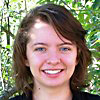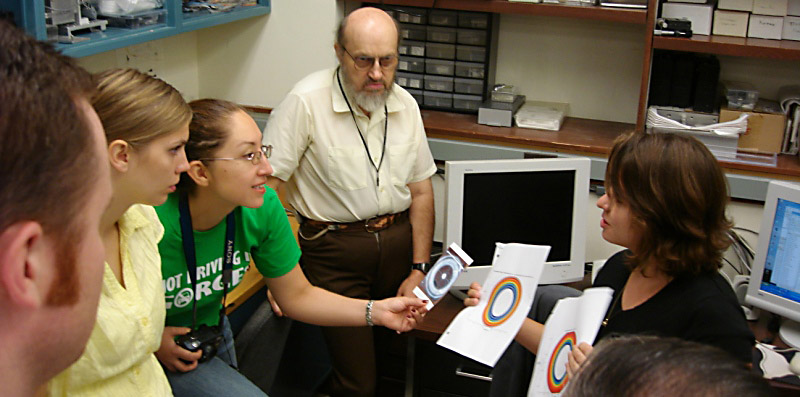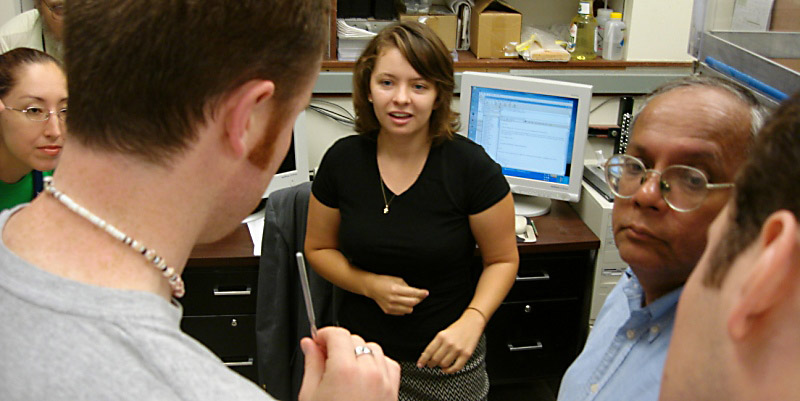X-RAY RUNS: Apply for Beamtime
2017 Nov 1 - Dec 21
2018 Feb 7 - Apr 3
2018 Proposal/BTR deadline: 12/1/17
2018 Apr 11 - Jun 4
2018 Proposal/BTR deadline: 2/1/18

Courtney Couvreur
(Contact: E. Fontes - ef11@cornell.edu)
Ithaca, NY - “Working with glass” is what high school teacher Courtney Couvreur decided to do the first summer after finishing a masters degree program in secondary education from the University of Michigan. This wasn’t anything recreational or artistic, though, but instead a research and development project working with the glass capillary x-ray optics group at CHESS, the Cornell High Energy Synchrotron Source. For years the CHESS glass group has been pioneering a process of heating and tapering hollow glass tubes to create a sort-of “funnel” for x-ray light. Capillaries can make small, micron-sized x-ray beams that can be used to probe buried layers in paintings for art historians, uncover fingerprints of air pollution in the growth rings of trees, or scan tiny regions of miniature protein crystals to help solve puzzles in membrane biology.
Courtney was supported at CHESS by a National Science Foundation (NSF) program called “Research Experiences for Teachers” that funds a grant to Wayne State University (WSU). In addition to funding high-school teachers through RET, NSF funds a sister program called REU – Research Experiences for Undergraduates – that supported more than a dozen undergraduate students this past summer who joined the teachers to form a small community of visiting researchers at Cornell. Both programs encourage participants to learn about science through hands-on activities and direct interactions with practicing scientists. WSU professor of physics Claude Pruneau coordinates of the RET program and is principal investigator on the NSF grant. The WSU program has helped more than 35 teachers participated in the program over 8 years and has always had a big effect on the teachers, with nearly uniform enthusiastic responses to questionnaires.
Courtney joined the glass optics group and worked closely with group leader Don Bilderback, associate director of CHESS, Sterling Cornaby, CHESS graduate student and Tom Szebenyi, CHESS technician (see http://capillary.chess.cornell.edu/). This summer capped off a year during which the group commissioned a brand-new capillary drawing tower – the device that heats and stretches the glass tubes to draw them into carefully designed shapes, or tapers. To achieve better focusing of the x-ray beams, making smaller and smaller spots, requires shaping the tapered hollow tubes as perfectly as possible.
Although they’ve gotten close a perfect shape and a perfectly smooth surface are both hard to achieve. They can tell the glass taper is not perfect by recording the focus of the x-ray beam at long distances. When an x-ray beam goes through the tube, it bounces off the walls and focuses to a spot. If a piece of film, or video camera, is place far downstream from the focal spot, the x-ray beams diverge and create a “bulls-eye” pattern. If the glass were perfectly smooth and formed into a perfect elliptically-shaped taper, the bull-eye pattern – also called far-field image – would show a uniform ring of x-ray intensity. Instead, the group has always found distorted and quite unusual images.
Can they use the far-field images to diagnose the glass and characterize the imperfections? They hoped so, and Courtney was given the task of figuring out it they could.
Her strategy was to learn to create far-field images from theoretical glass tapers and then work backwards to see if the images might be used to predict the shape of the glass. She had to learn to write MATLAB macros – like small computer programs - that could mimic the behavior of a real glass capillary. To make her imaginary capillaries less perfect she decorated the walls of glass with varieties of short and long wavelength undulations. She drew on her experience as a mathematics major in college to go one step further; building into the program a geometric model that bounced x-ray beams off the wavy glass surface to produce pseudo far-field x-ray images. In other words, her imaginary capillaries produced fake Polaroid pictures. Getting her fake images to match the real ones will help the optics group understand how surface and shape imperfections cause real images.

Courtney Couvreur, right, shows a far-field x-ray
photograph from a glass capillary (black and white
Polaroid) and compares it to color images generated
from here modeling program. The audience was a group
of RET teachers who were hosted for the summer by the
Cornell Center for Materials Research. Tom Szebenyi
(center, back), is a member of the capillary optics
fabrication team.
Courtney admits that during her freshman year in college, while studying engineering, she “just didn’t get it.” She failed to appreciate, in retrospect, how well a mathematical model could be built to capture and explain actual, observable physical phenomena. Her college experience was theoretical, which she understands better now that she spent the summer at CHESS doing just the opposite. “To my surprise I now understand how much math, even high school math, is useful!”
Graduate student Sterling Cornaby, who has worked in the capillary optics group for the past 4 years, was pleasantly surprised with Courtney’s work. He admits that his intuition about far-field images was lacking; “I expected that a small ripple added to the glass would be able to explain the distortions we see in the far-field images. Instead, she has proven to me that both long and short wavelength ripples are needed, in some intricate combination, to explain what we see. We need to avoid both types of waves to achieve the perfection that we want.” He explains that the group wanted to tackle this modeling project for more than a year but could find neither time nor the right person to take it on. “I’m really impressed with how much Courtney has done in just a few short weeks! When she gets stuck on something I might help with a bit of MATLAB programming, for example, but once she’s unstuck she’s off again at top speed.”

Holding a glass capillary makes most novices nervous
until Courtney, center, allays their fears that the
glass is strong enough for moderate handling.
Courtney gave a final presentation of her work to an audience overflowing the CHESS seminar room. When asked about the benefits the RET program and hosting teachers, Sol Gruner, director of CHESS, extols that “getting an undergraduate excited about science is a wonderful thing to do.” “But if you give a high school teacher a good science experience, one they can take back to the high school and pass to many students, then you have a fantastic multiplier effect.” The NSF and CHESS share a common goal: to get more students into careers in science. Because teachers stand in front of students almost 180 days each year, they have an immediate influence over student attitudes and expectations. When a teacher leaves CHESS with a better understanding of science and first-hand knowledge of how exciting research can be, there is little doubt they will spread enthusiasm and – hopefully - inspire more students to continue to pursue science as they enter college.
On her last day Courtney admitted that she’s really excited to take on the challenge to adapt math instruction to excite and inspire her students. Motivation is a challenge, she adds, but seeing how much fun it can be to model and describe real world systems, and seeing how science “bubbles” every day at CHESS, has transformed her ideas of teaching math and science in ways that she could not have learned in a classroom. CHESS wishes her every success in the future.
